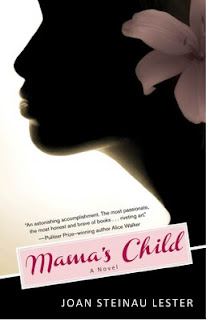Mama's Child follows twenty-three years in the life of Lizzie O’Leary, an idealistic young white woman who travels to the American South as a civil rights worker. She meets, falls in love with, and marries Solomon Jordan, a musician and fellow activist, who is black. Together, the young couple settles in the more liberal San Francisco area and starts a family: daughter Ruby, and son Che. They remain deeply involved in the Black Liberation Movement: participating in protest marches, and living in a home filled with Black Power posters, jazz, protest songs, and visiting Black Panthers.
But by 1978, when the novel opens, there is tension between the couple. Solomon’s music career keeps him away from home too much, and Lizzie is frustrated: “I need you here. I can’t raise these kids by myself. And they need a black parent, some days I just don’t know what to do.” Eventually, the strain becomes unbearable, and they divorce when their children are still young.
Their divorce deeply affects daughter Ruby, who is already suffering from a confused sense of self—“Am I black or white?” she continually asks herself. “Where do I belong?” She struggles with her own racial identity as well as her anger at her mother for splitting up the family. As for mother Lizzie, despite her attempts at trying to hold on to the emotional cord that binds them, the rift between mother and daughter widens.
It isn't until Ruby herself becomes a wife and mother that she begins to develop compassion and understanding for the many ways that her own mother’s love transcended race and questions of identity.
Told in chapters alternating between the voices of the mother and daughter, Mama's Child goes deep into the raw emotions of love, family, and ancestry - from two points of view.
My thoughts about Mama's Child ~~
Mama's Child gives the reader a very realistic look at the trials, tribulations, and joys of living in a bi-racial family. It can't be easy. This work of fiction reads like an autobiography of the author. Joan does an excellent job of telling the story using two points of view, alternating between the mother and the daughter.
Their relationship is sometimes very good and sometime very rocky. Part of their issues stem from the fact that they are, technically, different races. And then there are the 'normal' issues most mothers and daughters experience as they both grow and try to find themselves. It was interesting seeing the story from both sides.
Mama's Child gave me an education about the Black Liberation Movement that I wasn't really aware of at the time it was happening, living in in my 'white' world. I enjoyed reading about this piece of history from the point of view of someone who lived it.
Excerpt
Prologue
1990
Ruby Jordan's fingers tingled, she was that eager to write her farewell.
Half an hour later, wrapped against a wind studded with sleet, she shoved the letter to her mother into a mailbox on Williams Street. The lip of the blue box swallowed the envelope addressed to Elizabeth O'Leary, 1507 Ashby Ave., Berkeley, California, 94703, as if it were any ordinary paper. She listened to it clank, stared at the metal box, and bit her lip as pain pricked her chest. But as quickly as the sting jolted her it vanished, leaving only a wash of longing that rose like acid. She swallowed it down. Not now, she swore, not on my own personal Juneteenth. Her mother had told her that white people used to have a terrible saying: I'm free, white, and twenty-one.Well, thought Ruby, snapping her fingers as she strode down the block, I'm free, Black, and twenty-three. Catch me if you can.
About the author
Dr. Joan Steinau Lester is an award-winning commentator and author of four critically acclaimed books: Eleanor Holmes Norton: Fire In My Soul; The Future of White Men and Other Diversity Dilemmas; Taking Charge: Every Woman's Action Guide; and her first novel, Black, White, Other: The Search For Nina Armstrong. She has won the NLGJA Seigenthaler Award in journalism and the Arts & Letters Creative Nonfiction Finalist Award. Taking Charge was nominated as a Best Women's Book by the San Francisco Women's Heritage Museum and Mama's Child was a Bellwether Prize finalist.
After receiving her doctorate in multicultural education, Dr. Lester served as the Executive Director of the Equity Institute, which pioneered the diversity wave of the '80s and '90s, for sixteen years. As a member of a biracial family, Lester’s lifelong passion has been writing about issues of racial identity. Her former husband and father of her children was black; she has been with a female partner/spouse for over thirty years. Lester’s writing has appeared in many newspapers and magazines, including Essence, Los Angeles Times, Chicago Tribune, San Francisco Chronicle, Huffington Post, and Cosmopolitan. She lives in Northern California.
After receiving her doctorate in multicultural education, Dr. Lester served as the Executive Director of the Equity Institute, which pioneered the diversity wave of the '80s and '90s, for sixteen years. As a member of a biracial family, Lester’s lifelong passion has been writing about issues of racial identity. Her former husband and father of her children was black; she has been with a female partner/spouse for over thirty years. Lester’s writing has appeared in many newspapers and magazines, including Essence, Los Angeles Times, Chicago Tribune, San Francisco Chronicle, Huffington Post, and Cosmopolitan. She lives in Northern California.
Connect with Joan
Be sure to check the sidebar for my current giveaways!




Thanks for this lovely giveaway. saubleb(at)gmail(dot)com
ReplyDeleteI love the cover, and I would enjoy reading the book. Thanks for having the giveaway.
ReplyDeleteharnessrose(at)yahoo(dot)com
Interesting time period
ReplyDeleteThis book looks really interesting. Thanks for the chance to win :)
ReplyDeleteSounds like a very interesting book. I love the time period it is set in. Thanks for having the giveaway.
ReplyDeleteayancey(at)dishmail(dot)net
Thanks for the wonderful giveaway.
ReplyDelete